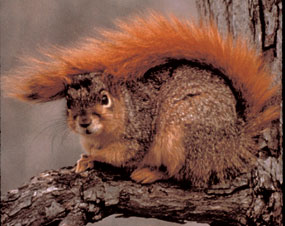Squirrels predict years of bounty
Squirrels predict years of bounty
mongabay.com
December 22, 2006
Squirrels are able to plan for the boom and bust seed production cycle of trees by producing an extra litter of babies in anticipation of a particularly rich season of tree seeds, according to new research published by scientists at the University of Alberta.
“Red squirrels are somehow able to predict years when a bountiful crop is about to occur and remarkably produce a second litter of babies to take advantage of the onslaught of food about to arrive,” said a statement from the University of Alberta. Dr. Stan Boutin from the University of Alberta’s Faculty of Science led the study which is published in today’s issue of the journal Science.
 Image courtesy of the U.S. National Park Service |
“Lots of animals time their reproduction to match predictable increases in resources like the new growth of plants every spring,” said Dr. Boutin. “But the interesting twist here is that these squirrels have figured out a way to produce this second litter of babies at a time when they have little food and before an unpredictable’ boom in seed production.”
“It’s like the squirrels are using a very successful stock market strategy. Most of us invest conservatively when the market is down because our funds are tight and we can’t predict when things will turn around. It’s not until the market has improved and is humming along that we increase our investment. Squirrels do the opposite, investing heavily when they have barely enough to get by but just before the market turns favorable. The result is that their investment —their babies—pay big dividends in the upcoming favorable market, which in this case is lots of seed.”
The researchers don’t know how the squirrels are able to predict the seed production cycle of trees though they speculate that the tree buds could provide a hint.
“Squirrels could be using a visual cue or a hormonal cue they gain from eating the buds,” said Boutin. “These squirrels are very clever because they use reliable cues to invest in extra offspring not when they can but when it makes sense evolutionarily.”
This article is based on a news release from the University of Alberta